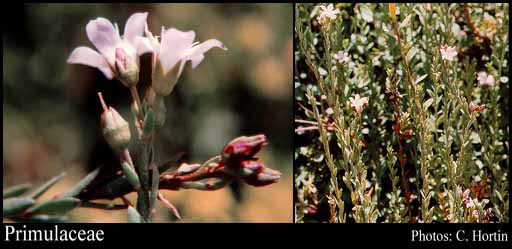- Reference
- Bot.Wörterb. 2:240 (1797)
- Name Status
- Current

Scientific Description
Common name. Primrose Family.
Habit and leaf form. Herbs; with coloured juice, or non-laticiferous and without coloured juice. Perennial (commonly), or annual; plants with a basal concentration of leaves, or with neither basal nor terminal concentrations of leaves; often rhizomatous, or tuberous. Hydrophytic (Hottonia), or helophytic to xerophytic (many alpine); the hydrophytic Hottonia rooted. Leaves alternate, or opposite, or whorled; when alternate, spiral; petiolate to sessile; non-sheathing; gland-dotted (perhaps, rarely), or not gland-dotted (usually); simple. Leaf blades entire (usually), or dissected; in Hottonia, pinnatifid; pinnately veined, or palmately veined; cross-venulate. Leaves without stipules. Leaf blade margins crenate to dentate (usually), or entire. Leaves without a persistent basal meristem. Leaf anatomy. Hydathodes commonly present. Stem anatomy. Nodes unilacunar. Secondary thickening absent, or developing from a conventional cambial ring, or anomalous (Hottonia, Primula p.p.).
Reproductive type, pollination. Fertile flowers hermaphrodite. Unisexual flowers absent. Plants hermaphrodite. Plants often heterostylous. Entomophilous.
Inflorescence and flower features. Flowers solitary, or aggregated in ‘inflorescences’; in heads, in umbels, and in panicles. Inflorescences scapiflorous (often), or not scapiflorous; terminal (commonly), or axillary; umbels, panicles or heads. Flowers ebracteolate; small, or medium-sized; regular; (3–)5(–9) merous; cyclic; tetracyclic, or pentacyclic. Free hypanthium absent. Perianth with distinct calyx and corolla (usually), or sepaline (the corolla absent in Glaux); (6–)10(–18); 2 -whorled (usually), or 1 -whorled; isomerous. Calyx (3–)5(–9); 1 -whorled; gamosepalous; imbricate, or contorted (e.g. Anagallis); regular; persistent (usually); with the median member posterior. Corolla (3–)5(–9); 1 -whorled; appendiculate (with staminodal scales), or not appendiculate; gamopetalous; imbricate, or contorted; regular; green, or white, or yellow, or red, or red, or purple, or blue. Corolla members deeply bifid to bilobed, or entire. Androecium (3–)5(–9), or 10. Androecial members adnate (to the corolla); free of one another; 1 -whorled, or 2 -whorled. Androecium exclusively of fertile stamens, or including staminodes. Staminodes when present, 4–6 (alternating with the stamens); when present, petaloid to non-petaloid (‘scales’, or resembling the staminal filaments). Stamens (3–)5(–9); isomerous with the perianth; alternisepalous. Anthers dehiscing via pores, or dehiscing via longitudinal slits; introrse; tetrasporangiate. Gynoecium supposedly 5 carpelled. The pistil 1 celled. Carpels usually isomerous with the perianth. Gynoecium syncarpous; eu-syncarpous; superior (usually), or partly inferior (Samolus). Ovary unilocular; 1 locular (and no evidence of partitions). Gynoecium stylate. Styles 1; attenuate from the ovary; apical. Stylar canal present. Stigmas 1 (simple); dry type; papillate, or non-papillate; Group II type. Placentation free central. Ovules in the single cavity (5–)7–100 (usually ‘many’); ascending; non-arillate; anatropous, or hemianatropous.
Fruit and seed features. Fruit non-fleshy; dehiscent (usually), or indehiscent (rarely); a capsule (usually), or capsular-indehiscent. Capsules valvular, or denticidal (usually five valved and dehiscing by apical teeth), or circumscissile (rarely). Fruit (1–)2–100 seeded (i.e. to ‘many’). Seeds endospermic. Endosperm oily. Seeds with amyloid. Cotyledons 1 (Cyclamen), or 2. Embryo achlorophyllous (5/10); straight. Seedling. Germination phanerocotylar.
Physiology, biochemistry. Aluminium accumulation not found. Photosynthetic pathway: C3.
Geography, cytology, number of species. World distribution: widespread, but centred in the North temperate. X = 5, 8–15, 17, 19, 22. 1000 species.
Keys
Western Australian Genera and Families of Flowering Plants — an interactive key
T.D. Macfarlane, L. Watson, N.G. Marchant